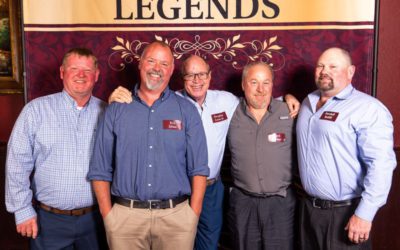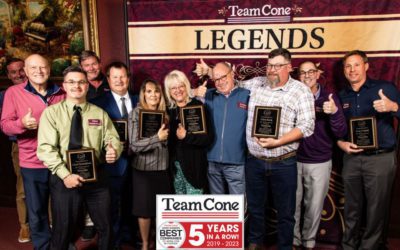Fish Hawk Spirits makes farm-to-bottle spirits from Dunnellon, Florida
Matthew Bagdanovich is a native Floridian who learned a trade and moved back to his home state to start a business. While that business, Fish Hawk Spirits, works each day to craft farm-to-bottle spirits, Matthew paused to talk about the company’s history, unique spirits, and attention to detail that make Fish Hawk’s Sui Generis whiskeys liquid gems.
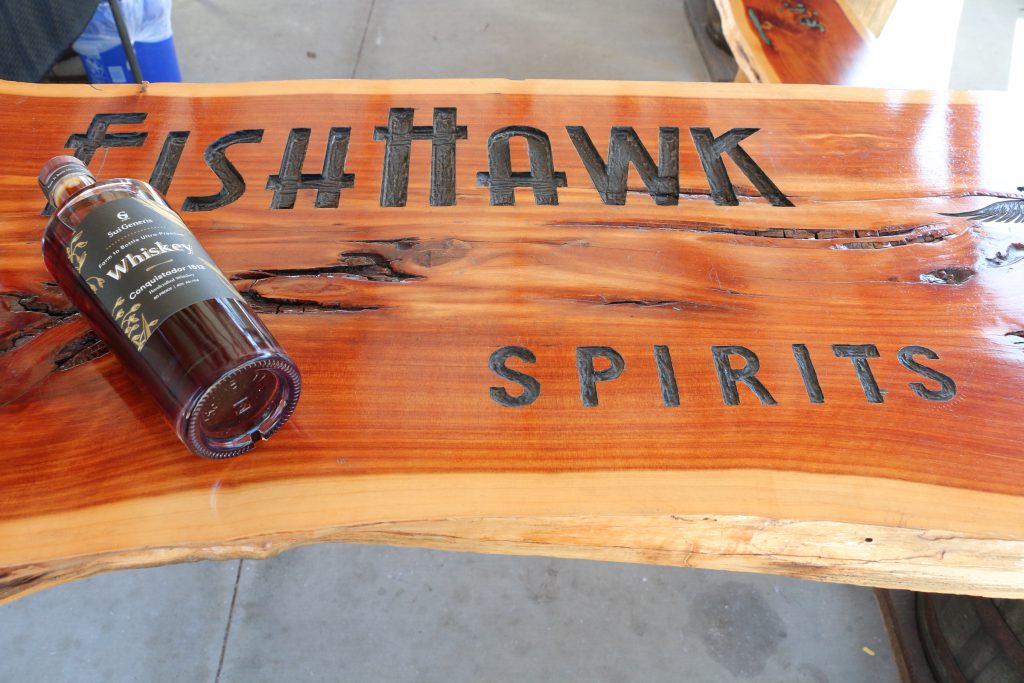
Matthew’s story begins with an experience abroad. “I learned to distill while living abroad, hand-taught by a master distiller down in Mexico.” I had made wines, and it was an easy transition to make to spirits. Distilling takes practice, and so Matthew did just that. “While I was in Mexico, my buddies and I distilled just about everything you can imagine. Lots of tropical fruit that does not grow up here. Some of it turned out great and some of it turned out so badly that we swore we would never do it again.” The transition was slow, but as Matthew became more experienced, he received more compliments on his work. “For 7- 8 years, we went from our friends cringing to folks asking for bottles when family was coming to town.”
Then, after a brief stint in the United Kingdom, Matthew decided to move home to Marion County, Florida. “We came home in 2005 after a total of 10 years abroad, and I needed a new business,” Matthew remembers. “Over a period of a few years, we learned that craft brewing had become a new thing in Florida. After that, I read a profile piece about the father of craft distilling in New York, and it all clicked.” Matthew’s hobby, combined with the right set of circumstances and a lot of work could lead to something. “It took 35 years for craft brewing to get to Florida, and the state was just beginning craft distilling. The only career options I had at this point was to go back abroad and do something I really didn’t want to do or open a craft distillery. Then the question was where.”
In searching for the distillery’s home, Matthew recounted his own Floridian roots. Standing on the farm in Dunnellon, Matthew says that while he “grew up in Volusia County, my mom went to Ocala high school – this is home home.” The search for Fish Hawk Spirits’ home started with a few friends looking for a place to distill. “We looked for properties that were zoned as Ag (agricultural) so that we could build on the property – these are considered farm buildings.” With an agricultural zoning, Matthew and company then focused on the next imperative for good spirits: water. Dunnellon delivered again. “When we found this location and tested the water, the water comes out of the ground absolutely pure. It comes out of the ground with total dissolved solids of 115 parts per million, no iron, a trace of calcium – that is classic whiskey-makers water.”
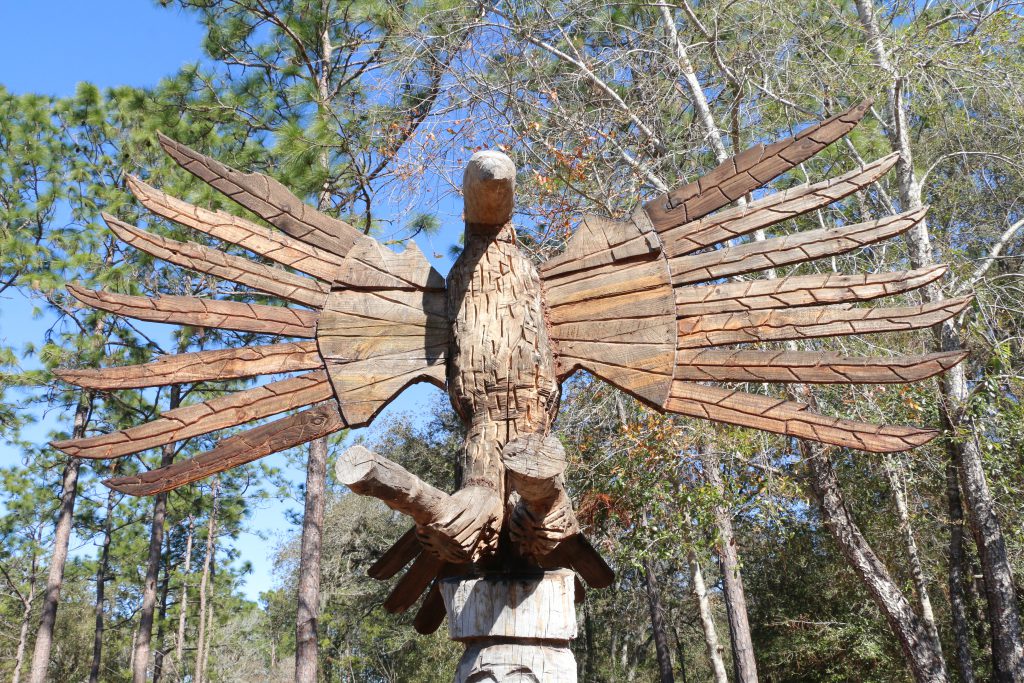
The beginning of a statue at the Fish Hawk Spirits farm
While whiskey making water made it excellent, Matthew soon sent off a sample to the lab for analysis, he remembers getting a phone call from the same lab. “We sent a sample to the lab in Louisville, and they tested it. Then the lab called us about our water and asked us where we got the sample.” While this could have gone either way, Matthew was intrigued. “We told them that it was the distilled water that we use for proofing liquor, and they said ‘no, where did it come from?’ We said that it came from the well on our property. They then told us that it was the single best sample they had ever tested.” With both agricultural zoning and the best water a distiller could ask for, Matthew and his partners began building Fish Hawk Spirits.
“A combination of zoning and beautiful water – guess where the distillery was going? That’s how Fish Hawk Spirits came to be here.”
Fish Hawk Spirits had to be a values-driven company
Matthew says that the next thing Fish Hawk needed after the company found its geographic home was to set in stone some key principles that the owners believed. Matthew remembers that “As a company, we made some decisions on a few values that we would operate under. One is we won’t use artificial color, we won’t use an artificial flavor, we won’t use a preservative.” After swearing off artificial products, Matthew says that it was important that the distillery became a part of the community. “We prioritize the acquisition of our raw materials by proximity to Dunnellon. We grow over half of the botanicals that we use for our absinthe right here on this farm and we’re expanding that this year. We grow some of the Silver Queen (corn) that makes up our Silver Queen whiskey here on this farm. One of my partners, Jack, is about a half mile down the road, we also grow on his farm. Then beyond that, if we don’t grow it, we look for a Marion County producer of it. If we can’t find it in Marion County, then we look for a Florida producer. We prioritize Alachua County and Hillsborough County. If we can’t find it in Florida, then a US supplier will do, but it must be a US grower. I’m not interested in doing business with the US office of a broker that sources material from China or Chile.” Matthew says that it is not a dislike for raw materials outside the US but simply a preference to be part of the community in Dunnellon, Marion County, and Florida. “I love Chile (I’ve never been to China), I love South America, but we simply prefer to do business with our neighbors. If we need tangerines, we’ll go to a Florida tangerine grove. If we need strawberries, then we’ll go down to Plant City. We do business with our neighbors.”
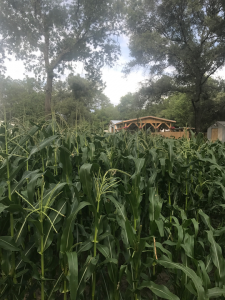
Corn grown on the Fish Hawk Spirits farm
One of the key components that those neighbors provide is fruit. Matthew says, “If we’re making vodka, brandy, or absinthe, that fruit comes in as fruit juice, with the exception of blackberry which comes in as raw fruit and we have to press it.” Since Fish Hawk Spirits insists on the best ingredients and processes, they insist on processing those fruits as well. “We take the concentrated juice and we press it to single strength juice. Then we dilute it to single strength because it is so dense, the sugar is not yeast-accessible when it arrives. We do everything we can to make sure that the liquid in that tank is the best growth media for the specific strain that we’re using on that particular product.”
“If we’re taking fruit juice or molasses and fermenting,” Matthew says, “then we’re actually making wine. If we’re taking grain, then we’re actually making beer. There’s a big difference between the beer that we make and the beer craft brewers make.” Sweetness in beer is not what he’s after,” Matthew says. “When we make beer, unlike craft brewers, we ferment every gram of sugar out of it. If sugar is left, then it is wasted. We’re not making beer, we’re making feedstock for the still. What we’re looking for is to make as many compounds that will be volatile at the same vapor point as ethyl alcohol.”
“In order to make whiskey,” Matthew declares, “we don’t start in the distillery, we start outside.”
Where Farm-to-Bottle magic happens
The heart of Fish Hawk Spirits’ commitment to quality can be seen on the farm where the distillery lives. It is a true farm with crops (many destined for the distillery) growing all over. Matthew’s focus starts when the grain is harvested and taken to the malt house.
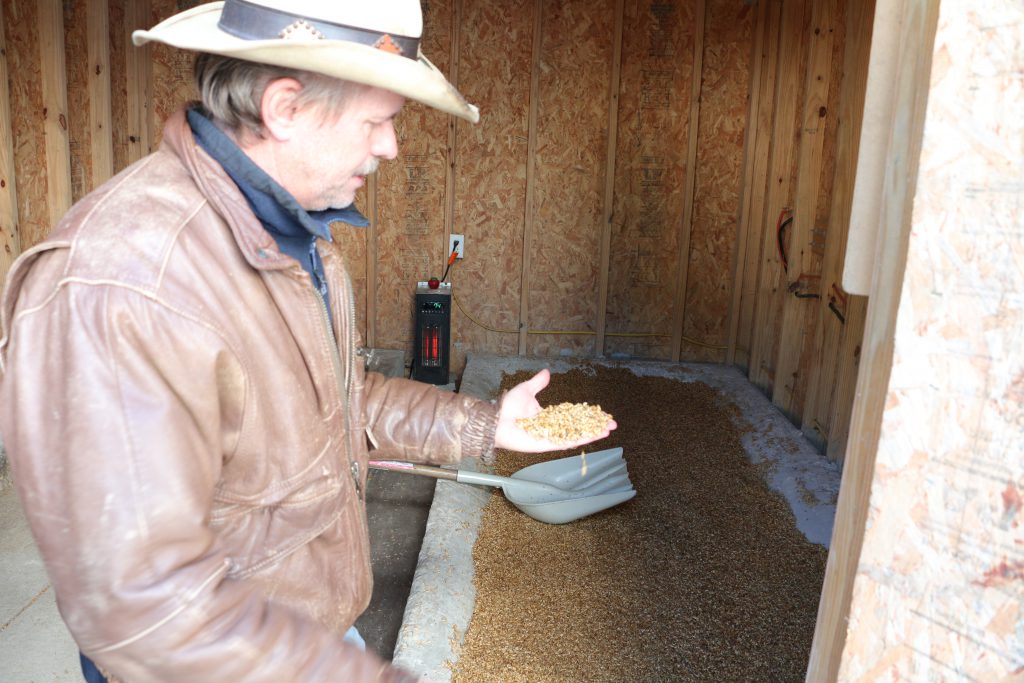
Fish Hawk master distiller Matthew Bagdanovich shows the malting beds
While many distilleries simply buy the grain that they want to use pre-processed, Fish Hawk Spirits prefers to control the process of malting. So after the grain (corn, oats, etc) is harvested, it makes its way to the malt house. “When we’re making our whiskey that is not Silver Queen, it starts in the malt house,” he says. “We have two malting beds that we alternate. If you look at the wet grain (green malt) you can see it beginning to sprout. This is the heart of our malting process. That malt is germinated and going to the roaster. Green malt comes over to the roasting oven, and we put it into the roasting oven.” The grain then moves on to the roaster.
The roaster has a two-fold function, Matthew explains. “This corn had the growth arrested with the heat of the roaster, we use the mix of cherry and oak because two things are happening – we’re drying but we’re also infusing the mash with the compounds from the smoke. A big part of the spirit’s flavor is made in the roaster, not in fermentation,” Mattew goes on. “When that whiskey comes out clear, the smoky flavor comes from this part of the process.”
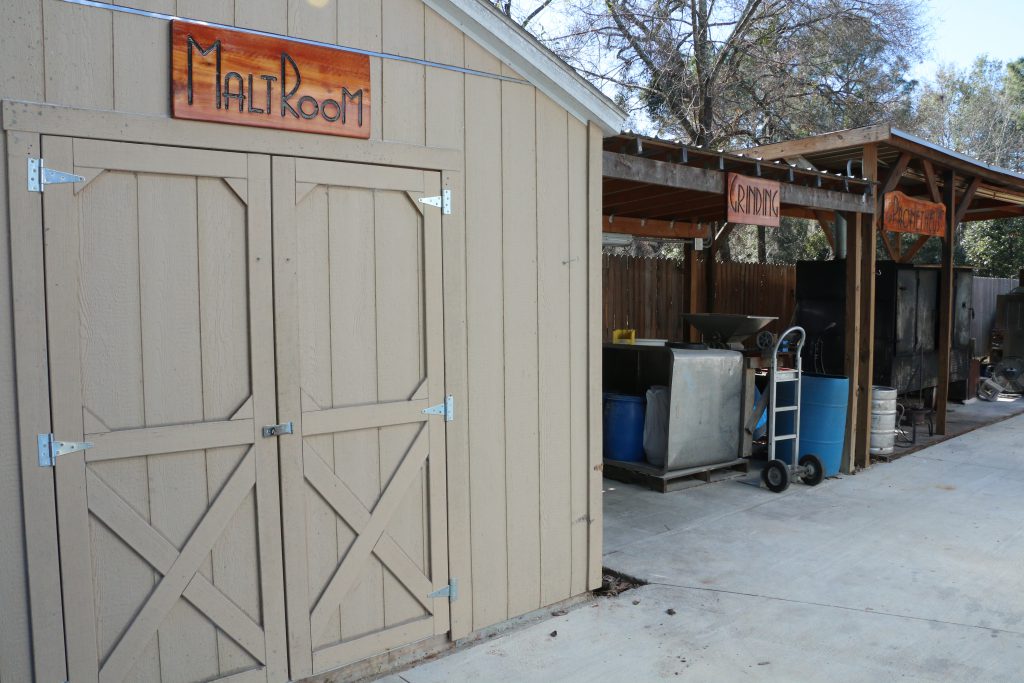
After the malt room, grain moves to the roaster
Matthew oversees the wood blend used in the roaster, but he sources the wood from his neighbors as much as he can. “We bring the wood in from outside, but we do business with our neighbors. In Marion County, if you trim trees, the county charges you to dump a load of wood. I made a deal with a few companies around here and said ‘If you’ll bring me wood, you can dump the wood on the front of the property for free.’ They get to dump on the property for free and we get free firewood.” To Fish Hawk, it takes a village to help raise a bottle.
After the grain is roasted, Matthew says, “We take the roasted malt, we grind it. We then boil 300 gallons of water then add 600-800 pounds of raw corn or oats. It makes a big pot of grits or oatmeal. The watery grain then goes through several steps of the distillation process – from low wine to high wine and then on to the finishing still.
The Spirits are Summoned from the Still
The headshot (the first part of the distilling run that is impure) is the next step in distillation. Matthew says that this is where attention to detail remains important and a virtue of Fish Hawk Spirits. The headshot is the first part of the run where the distillate emerges from the still with impurities. Matthew says that while they could collect these and sell them, it was a company choice not to. “We don’t reuse any of them – except for cleaning and starting fires. It’s also where you find the compounds like cyanide, aldehydes, acetone, and ketones. It is perfectly legal for us to sell you a bottle of vodka containing up to 60 parts per million of sodium cyanide. We simply choose not to.”

That headshot is then separated out and as the prime distillate emerges, Fish Hawk staff will taste the product until the best spirit emerges. “We separate everything that is not clean, pure ethyl alcohol,” Matthew emphasizes. “The final ‘proof in the pudding’ is that we don’t begin collecting product until we taste it – adjusted for each raw material that is being processed. We do not collect product below 100 proof.” Matthew is adamant that “The only thing that goes into our bottles is that top, sweet heart of the run.” After all, what good is all the other attention to detail if inferior spirits are allowed into the bottle?
Matthew proves his mastery of distillation as he reiterates the importance of each step in the process. Matthew has a simple but powerful philosophy on distilling that he says multiple times. “If it affects quality, we do it.”
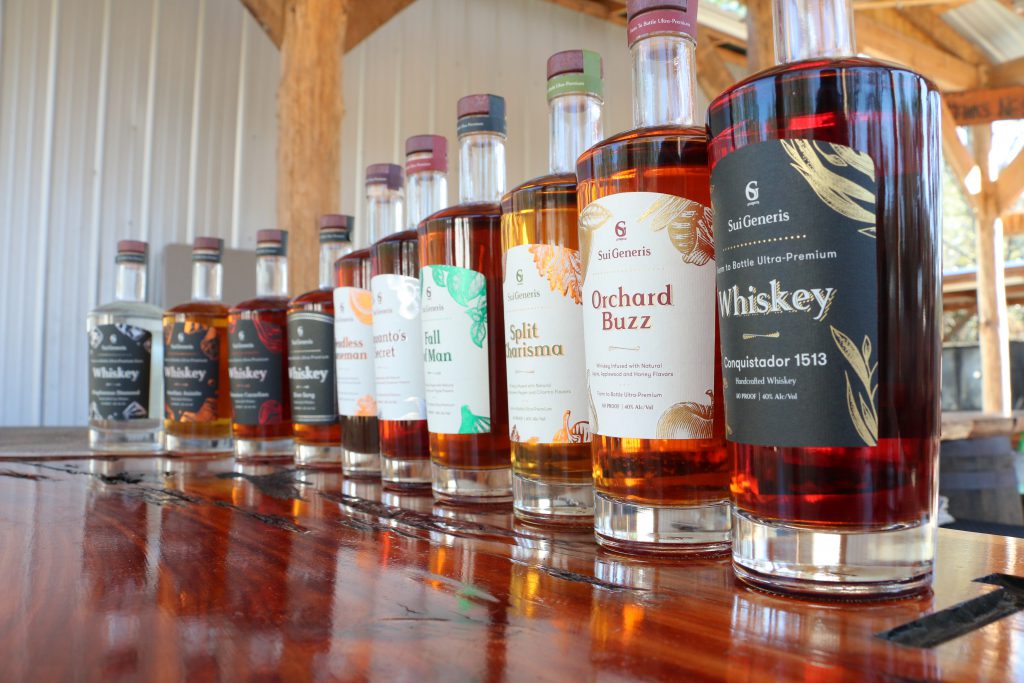
“In order of priority, the number one thing that affects the quality and flavor of your product is the fermentable – which is why we use the very best raw materials that we can get, why we insist on processing the raw materials – we don’t buy malt, we don’t buy precursor anything. We do it. That malt isn’t going to go into the smoker before we see 95% germination. If it affects quality, we do it. The second most important thing that affects the flavor is the water. I told you about our water. The third most important is the yeast. We have a different yeast for each product. The last thing that has a big impact on flavor is the distilling technique that I just described. If we were using crappy materials and crappy water, then none of our attention on the distilling side is going to suddenly make our product good. What we’re doing is taking really nice raw materials, really good yeast, and really nice water and we’re not screwing it up.”
Fish Hawk Spirits has been operating their distillery in Dunnellon since they were licensed in 2012. Their first bottles went into distribution in 2013. Matthew says that it has been slow and steady growth since then, but one thing he is most proud of is seeing his idea of a distillery come to fruition. “There is a tremendous amount of satisfaction when you go from a concept, which in 2009 was in my mind, to 2018 where we have 15 employees, 23 products and we’re talking to Team Cone about rolling out new products.”
Matthew and his partners have made a company that makes true farm-to-bottle spirits in Florida – a reality where they used sweat equity to turn musings into accomplishments. Matthew muses, “There’s great satisfaction in going from the conceptualization of an idea to the realization of it that the execution of the realization brings accomplishment. If we don’t accomplish, what are we doing?”



